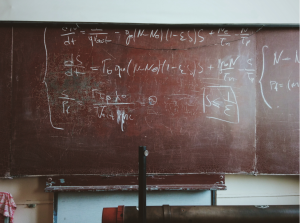Work is becoming increasingly project-based; the ability to navigate networks and work within a team towards the completion of simple and complex projects will progressively be what is required of the future workforce. Unfortunately, we are still basing our education system today on models and content that were appropriate 50-100 years ago but that are no longer so in our interconnected and post-digital world. Not only is a lack of engagement in students inevitable, but it is also a disservice to young people who are not being equipped by schools for the reality they will face when they leave.
Standardized vs flexible
Innovation in education today faces a conflict regarding standardized knowledge and testing vs. flexibility and personalization. What kind of systemic solutions can emerge form that conflict?
Using the systems thinking tool known as the Core Conflict cloud, we arrive at solutions by invalidating the assumptions (mental models) that keep us trapped in between two conflicting positions. The diagram below shows the conflicting positions, the underlying assumptions in the blue box, and the statements that invalidate those assumptions (the solutions) in the pink box.
Where schools are stuck: mental models
We are kept stuck in outmoded educational practices by assumptions that we can and must challenge. Firstly, we must have the courage to examine and refute such assumptions as:
Moving towards post-digital solutions
Once we challenge these mental models, we open up the space for new solutions that break through the barriers of anachronistic thinking and practice. We then have the opportunity to design a school system that fully recognizes the paradigm shift to our new, systemic understanding of the world and its interdependencies, and close the yawning gap between what goes on in most schools today and the way we actually live and work in a post-digital world. We need to create schools for an age of complexity, one that requires new knowledge, new skills and a different, more systemic kind of active, collaborative intelligence.
The solutions (see pink box) can then embrace the notion that once a school has decided the basic elements of information and knowledge it wants to deliver, it can develop in students the ability to interconnect those elements to develop new knowledge. By equipping students with the tools, both physical and mental, to think and analyze systemically and see the interdependent network among bodies of knowledge, they simultaneously learn and put into practice a lifetime skill. They will also be creating knowledge as opposed to simply receiving it passively.
Within the curriculum, accelerated learning patterns can be designed to accommodate and leverage students’ natural inclinations, and alternative assessment methods to standardized testing (which essentially test students’ ability to cope with the test as opposed to their knowledge) can be developed through original projects. By placing emphasis on developing students’ ability to plan, execute, validate and improve projects (see Deming’s PDSA cycle) students learn and acquire the ability to become valuable contributors to any organization. As we stated at the beginning, work is becoming increasingly project-based; the ability to navigate networks and work within a team towards the completion of simple and complex projects will progressively be what is required of the future workforce. We need to educate towards that.

Sign up to our blog here and shift your thinking towards broader, systemic possibilities for yourself and your organization.
About the Author
Angela Montgomery Ph.D. is Partner and Co-founder of Intelligent Management, founded by Dr. Domenico Lepore. Angela’s new business novel+ website The Human Constraint looks at how Deming and the Theory of Constraints can create the organization of the future, based on collaboration, network and social innovation.
See also:
Educating for Complexity: How Do We Transform Schools into Centres of Innovation?
Innovation and Education: The School of Evolution
Reality is Not Made Up of Cycles but Complexity: Education and Innovation Pt. 2
Looking at the Core Conflict in Education and Innovation Today (Pt. 3)






Leave a Reply